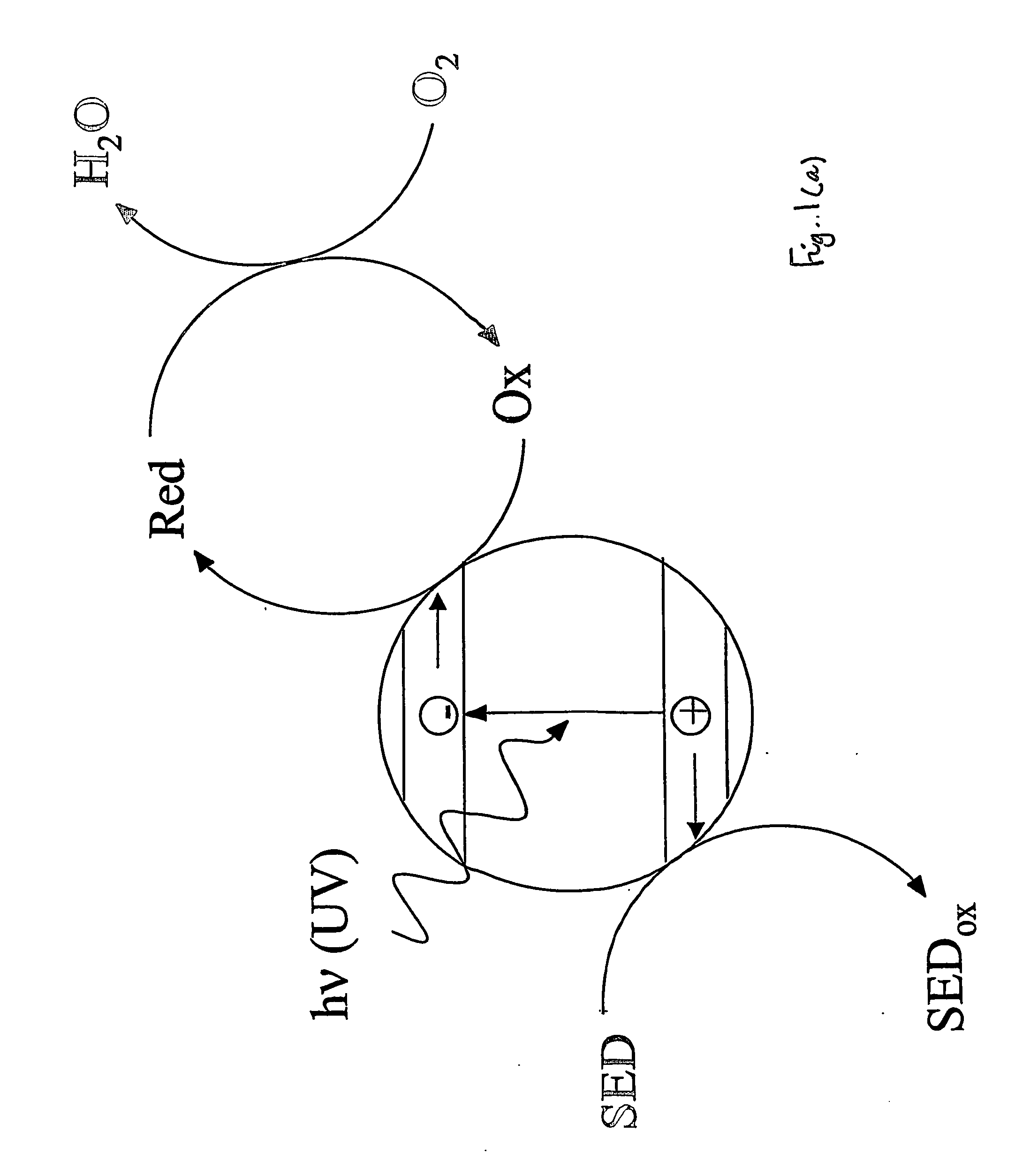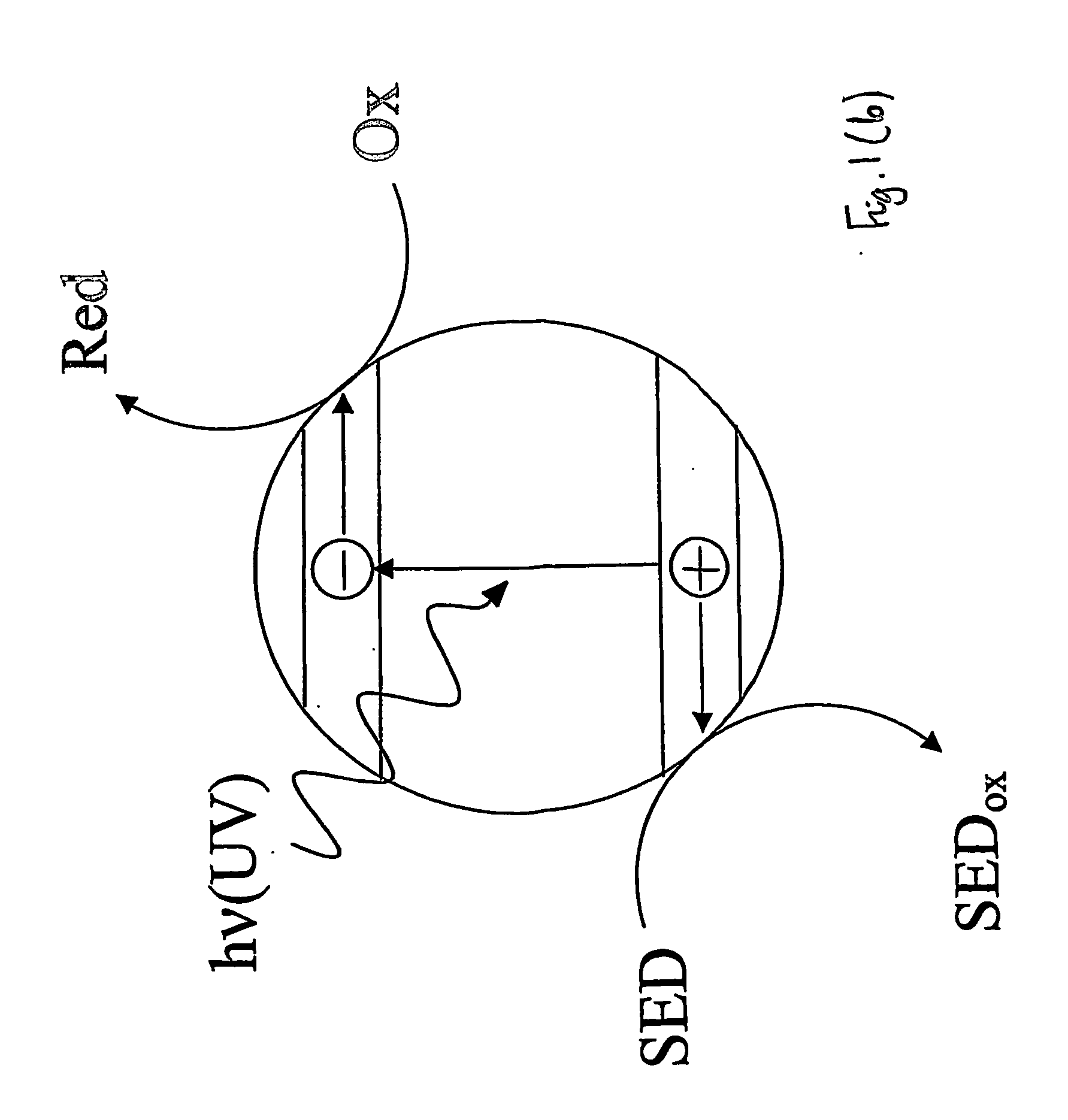Indicator for detecting a photocatalyst
a technology of photocatalyst and indicator film, which is applied in the direction of chemical reaction analysis, instruments, and analysis of materials, can solve the problems of difficult to determine which difficult to demonstrate the effect of the non-crystalline particles, and difficult to determine the side of glass or inert substrate, etc., to achieve the effect of increasing the photocatalytic activity of the underlying photocatalyst, reducing the number of measurements, and reducing the number of indicators
- Summary
- Abstract
- Description
- Claims
- Application Information
AI Technical Summary
Benefits of technology
Problems solved by technology
Method used
Image
Examples
example 1
Methylene Blue (MB / TEOA / HEC)—Titania Film on Glass
[0076] This Example represents a typical photocatalyst indicator that operates via a reductive mechanism and is reversible when used in air.
[0077] A typical indicating ink was prepared as follows: 10 mg of methylene blue (MB) and 0.4 g of glycerol were mixed with 4 g of a 2.5wt % aqueous solution of hydroxyethylcellulose (HEC) using a magnetic stirrer (30 minutes). The photocatalyst indicator ink was then cast onto a 25 mm square piece of glass comprising a coating of nanocrystalline titania 4 microns thick.
[0078] Blank experiments carried out under anaerobic or aerobic conditions using a film identical to Example 1 except with no semiconductor present showed no change in colour upon exposure to ultra bandgap light (i.e. light of wavelength less than 420 nm). This shows that the photocatalyst indicator does not change colour upon ultra bandgap irradiation unless a photocatalyst is present.
[0079] In contrast, when the ink is coate...
example 5
Resazurin (RZ / glycerol / hydroethylcellulose)—Titania Film on Glass
[0087] This Example represents a typical photocatalyst indicator that operates via a reductive, unlike previous Examples 1-4, mechanism and is irreversible.
[0088] A typical film was prepared as follows: 4 mg of resazurin (RZ) and 0.3 g of glycerol were mixed with 3 g of a 1.5 wt % aqueous solution of hydroxyethylcellulose (HEC) using a magnetic stirrer (30 minutes). This photocatalyst indicator ink was then cast onto a 25 mm square 4 mm thick float glass covered with a CVD coating (25 nm thick) of titania.
[0089] Blank experiments carried out under anaerobic and aerobic conditions using a film identical to Example 1 except with no semiconductor present showed no change in colour upon exposure to ultra bandgap light, i.e. light of wavelength less than 420 nm. This latter experiment shows that the photocatalyst indicator does not change colour if there is no underlying photocatalyst present. In contrast, when a photoca...
example 8
Methyl Orange—Titania Film on Glass
[0093] A typical photocatalyst indicator that operates via an oxidative mechanism and is irreversible.
[0094] An example of an irreversible, photocatalyst indicator that operates via an oxidative mechanism is the MO indicator, i.e. Example 8 in Table 1. Such indicators can be prepared by simply making an aqueous solution of the dye and then coating the dye onto the photocatalyst film under test. Air is usually used as the sacrificial electron acceptor. Irradiation of the film only produces a colour change (orange to colourless) when there is an underlying photocatalyst present. Typical results for this film are illustrated in FIG. 9.
[0095] The nature of the semiconductor (but not its concentration in the indicator formulation) used in oxygen indicator was also varied from that used in Example 1 and characterised as described above. In this work all other experimental components and additions were used in the preparation of Example 1. The results ...
PUM
| Property | Measurement | Unit |
|---|---|---|
| wavelength | aaaaa | aaaaa |
| wavelength | aaaaa | aaaaa |
| wavelength | aaaaa | aaaaa |
Abstract
Description
Claims
Application Information
 Login to View More
Login to View More - R&D
- Intellectual Property
- Life Sciences
- Materials
- Tech Scout
- Unparalleled Data Quality
- Higher Quality Content
- 60% Fewer Hallucinations
Browse by: Latest US Patents, China's latest patents, Technical Efficacy Thesaurus, Application Domain, Technology Topic, Popular Technical Reports.
© 2025 PatSnap. All rights reserved.Legal|Privacy policy|Modern Slavery Act Transparency Statement|Sitemap|About US| Contact US: help@patsnap.com



